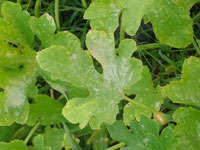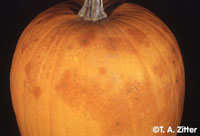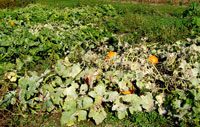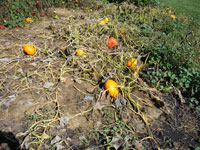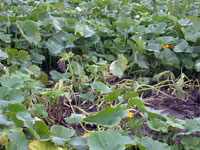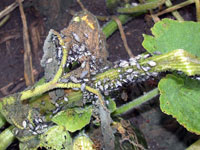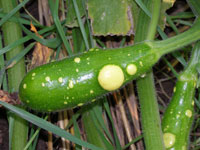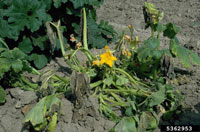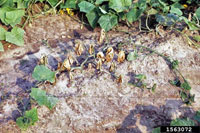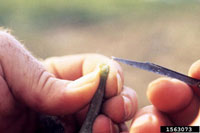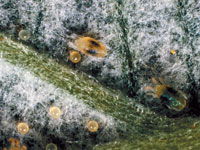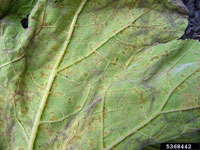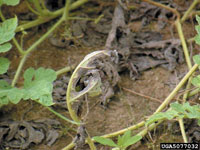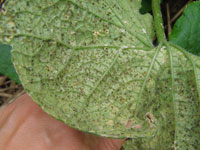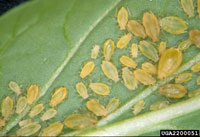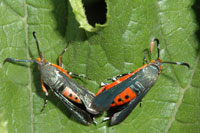Extension > Garden > Diagnose a problem > What's wrong with my plant? > Vegetable > Cucumber > Discolored leaves
Cucumber > Leaves > Discolored leaves
1 of 9
Powdery Mildew
Podosphaera xanthii
- Initially pale yellow spots develop on the oldest leaves
- White to gray powdery felt in spots, blotches or complete covering of leaves
- Lesions develop on underside of leaves, or on shaded leaves first
- Older leaves infected first
- Severe infection can cause leaves and vines to wither and die
- Fruit may be blotchy or have sunscald
- More information on Powdery Mildew
2 of 9
Cold Temperature
- Weather has been cold (below 50°F) and wet
- Soil is cold (below 62°F) and damp to the touch
- Leaf edges turn olive green to brown
- In severe cases entire leaves, young shoots or the entire plant may be completely discolored and wilted
3 of 9
Squash Bug
Anasa tristis
- Feeding can cause yellowing and wilting
- More common on squash and pumpkins than cucumber
- Adults are 5/8 inch long, somewhat flattened, and gray to dark brown with alternating orange and brown stripes on the edges of their abdomen
- Nymphs are 1/10 to 1/2 inch and are a light to dark gray color
- Active from May through September
- More information on Squash Bug
4 of 9
Virus
Squash mosaic, cucumber mosaic, watermelon mosaic
- Irregular, blotchy to wavy patterns of yellows and greens on leaves
- Leaves may be distorted (sometimes fern-like), wrinkled, and curled
- Plants may be stunted
- Fruit may have unusual color patterns, blotches or rings but are not rotten
- Fruit are often deformed and distorted
- More information on Virus
5 of 9
Bacterial Wilt
Erwinia tracheiphila
- Leaves first appear dull green, wilt during the day, and recover at night
- Eventually wilted leaves die
- Wilt progresses down the vine until entire vine is wilted or killed
- Striped or spotted cucumber beetles will be present in the garden
- Cucumbers and muskmelon most commonly affected (pumpkins and squash less affected)
- More information on Bacterial Wilt
6 of 9
Spider Mites
Tetranychus urticae
- Feeding on the underside of leaves causes leaves to appear pale and stippled
- Webbing can be found on underside of leaves when heavy infestations are present
- Adult spider mites are very small (approximately 1/50 inch in length), and are yellow to dark crimson, with dark spots
- Mites usually appear in late June and August, and are more prevalent in hot, dry weather
7 of 9
Downy Mildew
Pseudoperonospora cubensis
- Pale green to yellow spots on upper surface of leaves, later turn brown
- Angular spots bounded by leaf veins
- Dark purplish grey fuzz on underside of leaf when high humidity
- In wet or very humid conditions disease progresses rapidly, leaves turn brown and look like they were killed by frost
- On watermelons, an exaggerated upward leaf curling is common
- Cucumber and muskmelon most susceptible
- More information on Downy Mildew
8 of 9
Aphids
Aphis gossypii, Myzus persicae
- Aphids feed on leaves, resulting in yellowing
- Leaves may wilt
- Small (1/6” – 1/8”) soft bodied insects
- Aphids can transmit viruses
- Active from April through October
9 of 9
Squash Vine Borer
Melittia cucurbitae
- Feeding by larvae causes yellowing of leaves and wilting
- Holes filled with green to orange excrement near the base of the plant may be present
- Less common on cucumbers
- Adult borer resembles a wasp, is active mid-June through July
- More information on Squash Vine Borer



